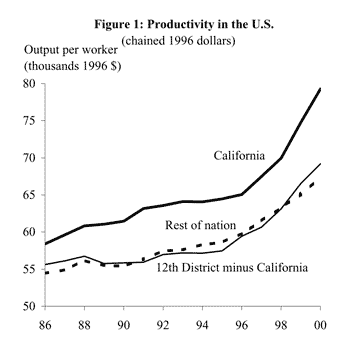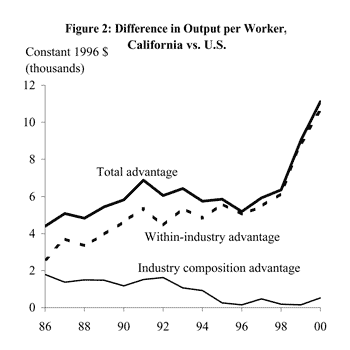Labor productivity, that is, real output per worker (or per worker hour), is a primary determinant of our long-run standard of living. More output per worker translates into higher profits, higher wages, or lower prices—or a combination of the three.
- Productivity in the Twelfth District vs. the rest of the nation
- Where does the productivity advantage come from?
- What makes Californian establishments more productive?
- Conclusion
- References
Regional Report. The Regional Report appears on an occasional basis. It is prepared under the auspices of the Financial and Regional Analysis Section of the FRBSF’s Economic Research Department.
Labor productivity, that is, real output per worker (or per worker hour), is a primary determinant of our long-run standard of living. More output per worker translates into higher profits, higher wages, or lower prices—or a combination of the three. Therefore, understanding why labor productivity is higher in one firm (or city, state, nation, industry, etc.) than another is of vital importance. This Economic Letter looks at the levels of output per worker in the Twelfth District, with an emphasis on California, compared to that of the rest of the nation and discusses the possible causes of regional differences in labor productivity.
Productivity in the Twelfth District vs. the rest of the nation
To see how Twelfth District states compare to the rest of the nation, I examine state-level data on real value-added (output) per worker. The value-added measure is inflation-adjusted Gross State Product (GSP), which is the state counterpart to the nation’s GDP. The most recent data on GSP are for 2000.
Six of the District’s nine states are in the top 40% of all states in terms of the level of output per worker in 2000. Alaska leads the nation, largely due to the prevalence of a few industries with very high value-added per worker (as well as high capital per worker), such as pipelines and extraction of oil and natural gas. Washington and Oregon also rank fairly high on the list, at 10th and 21st place, respectively (both above the national average).

California, the largest District state, ranks sixth in the nation in labor productivity. Figure 1 shows that, despite the high output per worker in some other District states, on the whole, the rest of the District has had a much smaller productivity advantage relative to the nation than California has had. Moreover, California’s advantage has been persistent, whereas the advantage of the rest of the District is quite recent.
The size of California’s productivity advantage has fluctuated over the business cycle. California stretched its advantage over the national average during the late 1980s and early 1990s only to give some of it back around 1993-1995. This reflects the fact that the recession of the early 1990s hit California a bit later and was much longer and deeper than in the rest of the nation (see Daly and Hsueh 2002); output per worker tends to fall during recessions because firms tend not to cut employment as readily as they cut production. After 1996, however, California extended its productivity advantage. It remains to be seen how the downturn since 2000 has affected this advantage.
Where does the productivity advantage come from?
When accounting for California’s considerable and persistent productivity advantage, there are two components to consider. One component is the industry composition in California—that is, California simply may have more of its employment in higher-productivity industries (as Alaska does). Another component is the performance of California business establishments within the same industries—that is, California establishments may be more productive than establishments in the same line of business elsewhere. “Establishment” here means a store, office, plant, or other single-location facility operated by a firm.

Figure 2 shows that in 1986 each component contributed about equally. But from then on, the within-industry component became more dominant, and by 2000 it was nearly the entire explanation for California’s productivity advantage. This implies that, on average, business establishments in California have been more productive than establishments in the same industry elsewhere in the nation.
One could argue with this conclusion, as the data on which it is based are available only at a fairly aggregate level. Specifically, the data are broken into 57 broad industry classifications, and these classifications may be so broad that they fail to capture fully the effect of industry composition on productivity differences. For example, the classification “business services” includes businesses ranging from temporary employment agencies to software development firms.
But three facts tend to support the conclusion that California business establishments do have productivity advantages over those elsewhere in the country. First, California’s productivity advantage is quite broad-based. Two-thirds of the 57 industries have higher productivity in California than in the rest of the nation. Second, California has a productivity advantage in industry classifications where the work is fairly well-defined, for example, retail trade, construction, wholesale trade, and health services, just to name a few. Furthermore, these well-defined industry classifications generally have much larger employment shares than do industry classifications covering more diverse businesses, such as “business services.” Therefore, they weigh more heavily in the evidence on the effect of industry composition on productivity. So, while some portion of California’s within-industry advantage may reflect higher productivity industries, the majority almost certainly reflects advantages at the level of business establishments.
What makes Californian establishments more productive?
There can be any number of reasons for the difference in productivity between any two establishments in the same industry. However, the sources of productivity differences that could vary systematically across geographic areas are relatively few. The economic literature on productivity suggests six primary sources. The first, and possibly most important, source is the quantity and quality of physical capital, particularly equipment, used in the production process. Unfortunately, we have very little data on capital investment at the state level, so it is difficult to quantify its importance.
The second potential source is more highly skilled labor, which tends to be reflected in workers’ compensation. In 2000, compensation per worker was about $52,000 in California and about $44,000 for the U.S. outside of California, indicating that more highly skilled labor is a likely contributor to California’s productivity advantage. To the extent that workers’ compensation reflects their marginal product (that is, their individual labor productivity), the higher levels of compensation imply a higher skill level for the average worker in California.
The next two items on our list of possible factors contributing to the state’s productivity advantage are very much intertwined: workplace practices and institutional structure. Because of differences in business culture and the like, firms in California may have organizational arrangements that allow them to be relatively more efficient. Valletta (2002), for example, argues that the business climate in California, particularly in Silicon Valley, tends to put fewer restrictions on workers who want to move from firm to firm or to leave to start up their own companies than business climates elsewhere. This employee mobility fosters the rapid diffusion of innovations and knowledge to other firms in the area. Such features of business practice can be influenced by the institutional structure of an area, e.g., its laws and financial institutions. For example, Valletta argues that the high degree of employee mobility in parts of the tech sector in California is facilitated by relatively unique features of California employment law that allow departing employees to take valuable trade knowledge with them to competing firms. The large number of venture capital funds in Silicon Valley is another element of the institutional structure that could confer productivity advantages to certain types of firms in that area, though the causation can also work in the other direction with the presence of high productivity firms drawing venture capital funds to the area.
Another source of productivity advantages at the establishment level is inter-firm spillovers, which are the productivity benefits that accrue to firms simply because of their proximity to other firms. For example, if firms in the same industry are located near each other, that may lead to increases in the interchange of ideas and talent, which then enhance the productivity of every firm in the area. Such spillover effects frequently are cited as a source of the success of Silicon Valley over the past several decades. Similarly, density itself (aside from the concentration of firms in a small number of industries) could lead to permanently higher output per worker for an area because of lower costs of transportation from producers to users and consumers (among other reasons). Thus, a state with a comparatively large number of dense economic centers may have a persistent productivity advantage. Ciccone and Hall (1996), in fact, estimate the extent to which a state’s production is generated in dense centers and find that California ranks ninth among U.S. states.
Closely related to these five factors is the sixth factor, namely, the choices firms make about where to locate specific activities. Large, geographically dispersed firms may choose to locate their highest value-added per worker activities (such as research and development), which also tend to be activities that require highly skilled labor, in locations where labor quality is high, knowledge spillovers are prevalent, and institutions are favorable for fostering innovation. In addition, by taking advantage of the local high-quality labor and favorable institutions, small, single-establishment businesses may produce higher quality (and higher priced) products than businesses elsewhere in the same broad industry produce.
It is clear that the Twelfth District as a whole has higher output per worker than the national average, though productivity varies considerably across District states. California stands out not only because of its size, but also because it has had a productivity advantage relative to the national average that is persistent, sizable, and expanding in recent years. Moreover, the advantage appears to be due largely to advantages at the level of business establishments.
The analysis here gives us a good handle on what the potential contributors to productivity are, but the relative importance of each is still not well understood. This is in part because both data constraints and conceptual difficulties have prevented researchers from simultaneously focusing on more than one source of the difference in regional productivity.
Without state-level data on capital investment, it is difficult to discern how much of a state’s productivity advantages are due to the more efficient use of all resources as opposed to simply “buying” the higher output per worker by giving workers more and better capital. Fortunately, comprehensive firm-level data sets have become available recently, and they are allowing researchers to overcome this hurdle and to gain a better understanding of regional productivity differences.
Daniel Wilson
Economist
References
[URLs accessed October 2002.]
Ciccone, Antonio, and Robert Hall. 1996. “Productivity and the Density of Economic Activity.” American Economic Review 86(1), pp. 54-70.
Daly, Mary, and Lily Hsueh. 2002. “Recession in the West: Not a Rerun of 1990-1991.” FRBSF Economic Letter 2002-06 (March 8). /economic-research/letter/2002/el2002-06.html
Valletta, Robert. 2002. “On the Move: California Employment Law and High-Tech Development.” FRBSF Economic Letter 2002-24 (August 16). /economic-research/letter/2002/el2002-24.html
Opinions expressed in FRBSF Economic Letter do not necessarily reflect the views of the management of the Federal Reserve Bank of San Francisco or of the Board of Governors of the Federal Reserve System. This publication is edited by Anita Todd and Karen Barnes. Permission to reprint portions of articles or whole articles must be obtained in writing. Please send editorial comments and requests for reprint permission to research.library@sf.frb.org